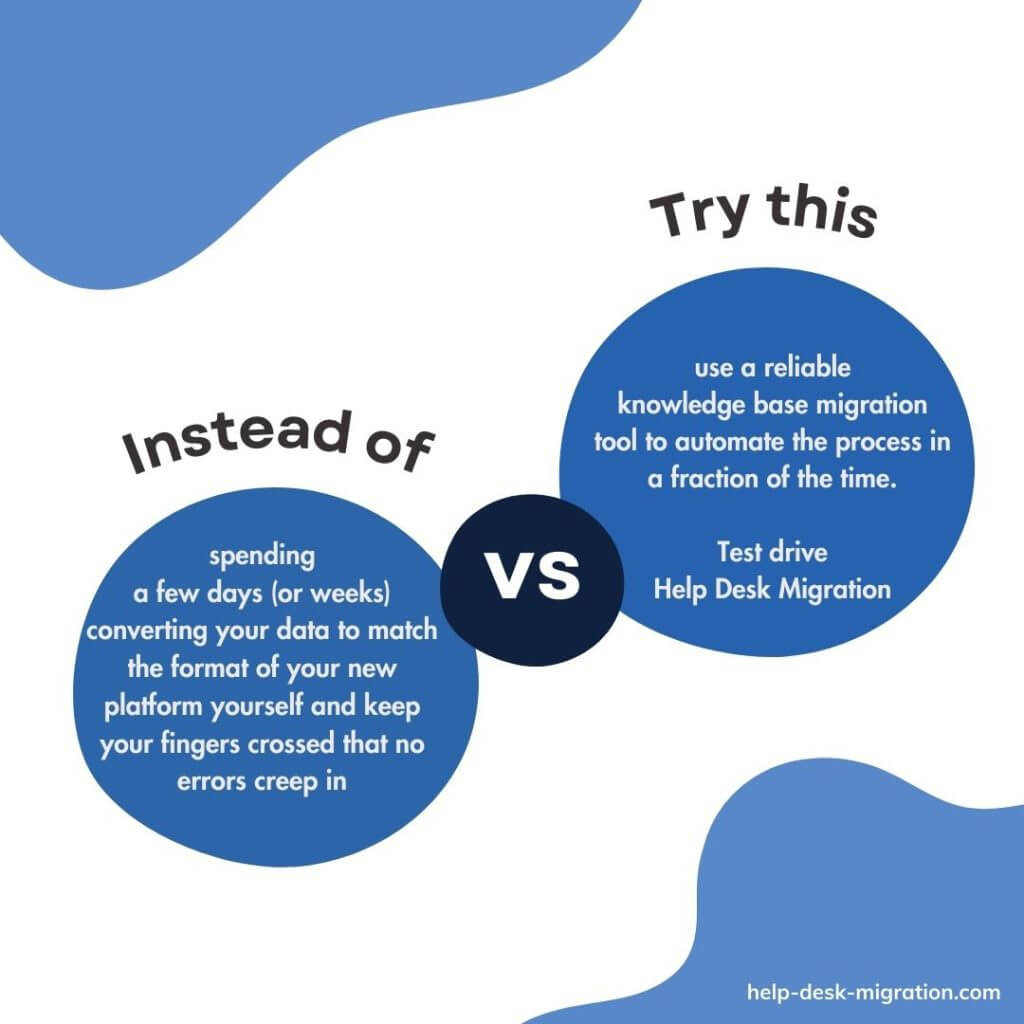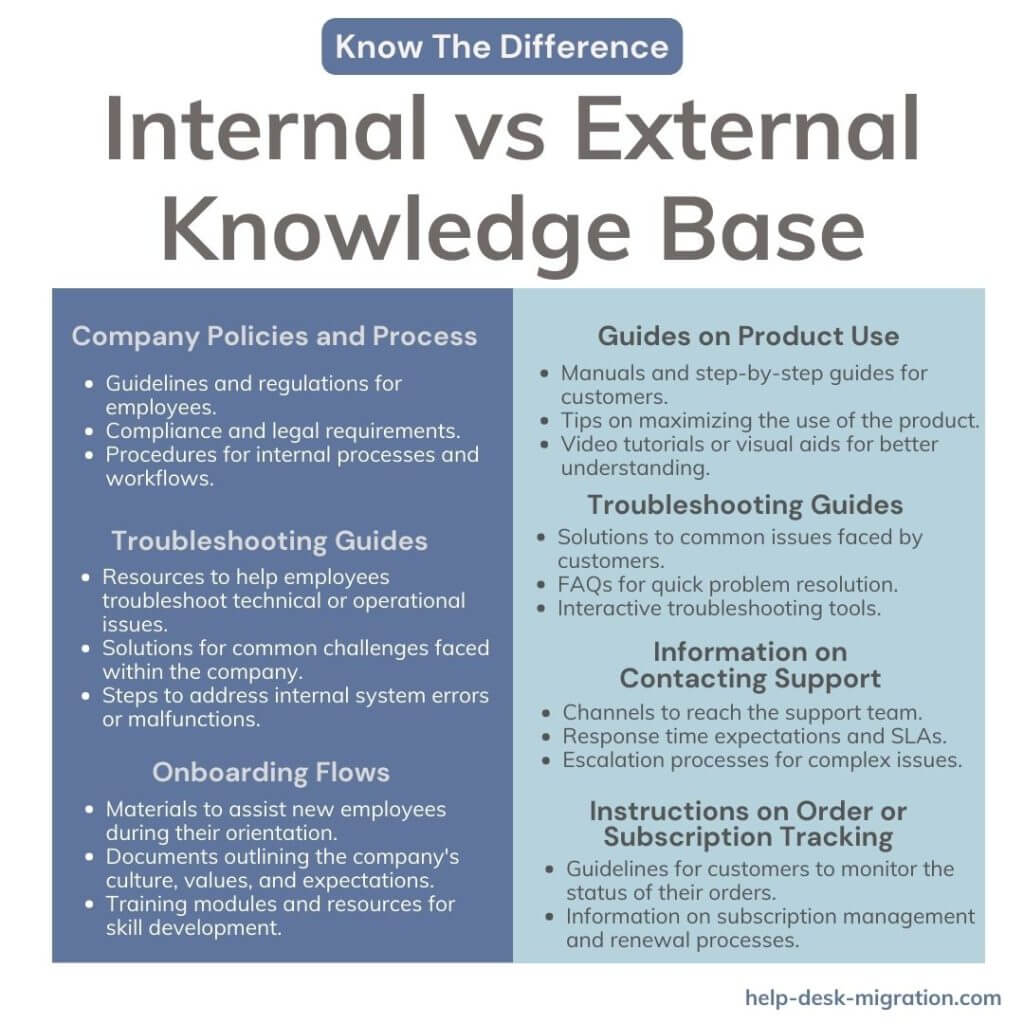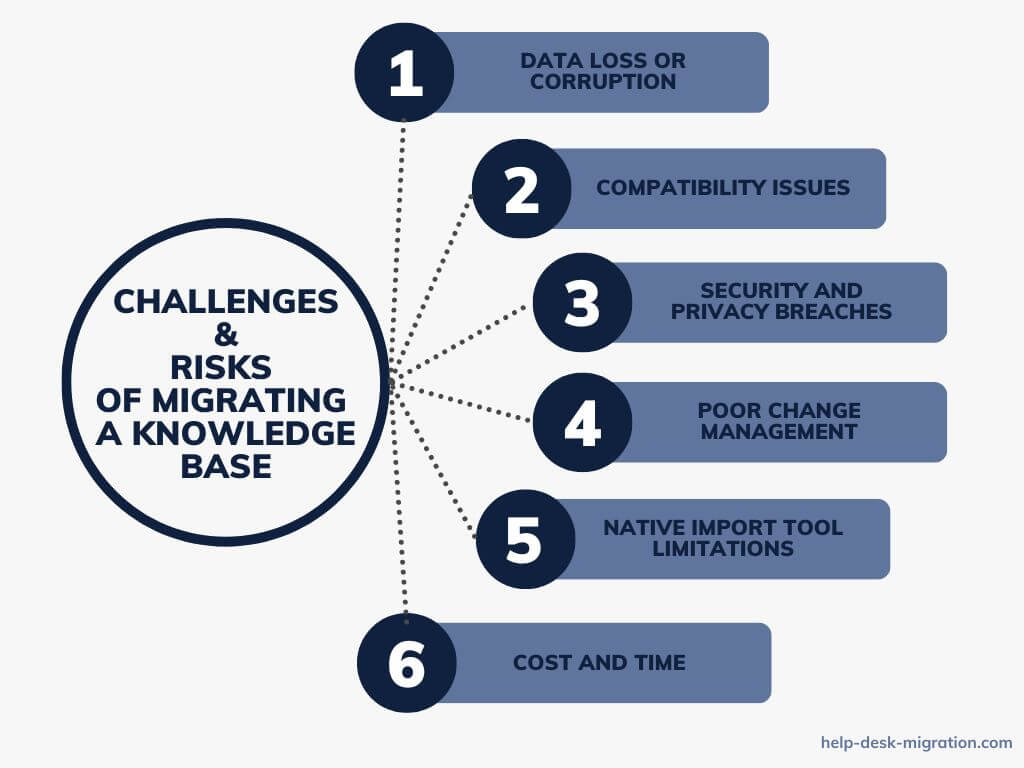It’s not unusual: a business puts instructions and how-to articles into a Cofluence’s Wiki to build a small knowledge base for employees. Meanwhile, an FAQ section on the website provides answers to common questions.
This approach to managing your knowledge base might work while you’re small. The problems start when you scale: you suddenly have hundreds of files and records that you want to combine in a more sophisticated knowledge management platform.
At this point, you have two main options:
- Spend a few days (or weeks) converting your data to match the format of your new platform yourself and keep your fingers crossed that no errors creep in, or
- Use a reliable knowledge base migration tool to automate the process in a fraction of the time.

Put like this, the right choice looks like a no-brainer, but if you care about your data, it’s normal to have questions. How could it help to migrate data from one external knowledge base to the other? Are there risks when transferring internal confidential documents? What about customer service uptime during knowledge base migration?
At Help Desk Migration, we have enough experience to answer all these questions with over 20,000 migrations under our belt. In this article, we’ll tell you everything you need to know to avoid common data migration pitfalls and ensure your transfer is seamless.
But first, a bit of terminology.
What Is the Difference Between the Internal and External Knowledge Base?
There are two main types of knowledge bases—internal and external. The key difference is who they serve.
- An internal knowledge base helps your employees (and sometimes contractors) work more efficiently. It stores information related to customer-facing and business operations. Some examples could be company policies and procedures, troubleshooting guides, and onboarding flows.
- An external knowledge base caters to your customers. Also known as a help center, it usually includes guides and instructions on how to use your product and troubleshoot common problems. This type of knowledge base also helps customers contact your support team or learn how to track their orders or subscription status.
Both internal and external knowledge bases have the same benefit—they are essentially a one-stop shop with all the information customers or support reps need to solve their issues quickly.

Meanwhile, an important benefit of an internal knowledge base is permission settings, which let you restrict and sort information for different groups of employees. An external knowledge base doesn’t have this feature, but it plays another important role—it allows customers to handle their issues without contacting the support service.
Despite these differences, you’ll face the same challenges and risks when migrating your data to a new knowledge base platform, whether it’s internal or external.
Exploring Knowledge Base Functionalities Across Help Desk Platforms
In the quest for the perfect help desk platform to meet organizational customer support demands, a thorough grasp of knowledge base functionalities becomes paramount.
Below, we provide an in-depth analysis of how top-tier platforms tackle key aspects such as internal and external knowledge base access, access rights, categorization and editing options, support for attachments, provision for multiple language versions, and the seamless inclusion of tables within knowledge base articles:
Freshdesk
Freshdesk stands out with its user-friendly design and efficient ticket management automation. The knowledge base functionality is a standout feature, facilitating seamless content creation, categorization, and searchability. This ensures that agents can promptly access pertinent information, leading to efficient resolution of customer issues.
- Internal and External Knowledge Base: Freshdesk supports both internal and external knowledge bases.
- Access Rights: Enjoy customizable access rights that provide control over viewing, editing, and publishing articles.
- Categorization and Editing: Robust categorization options and an intuitive editor simplify content creation and organization.
- Attachments: Support for various attachment formats enhances content richness.
- Multiple Language Versions: Ensure global accessibility with multilingual support for presenting knowledge base articles in different languages.
- Tables: nhance information structure by seamlessly including tables within knowledge base articles.
Help Scout
Help Scout excels in simplicity and collaborative features, making it a standout choice. The knowledge base facilitates effortless content creation and sharing, promoting transparency within the team. The platform's straightforward approach ensures both agents and customers can navigate information seamlessly.
- Internal and External Knowledge Base: Help Scout caters to both internal and external knowledge bases.
- Access Rights: Benefit from granular access controls, allowing teams to precisely define who can access, edit, and contribute to the knowledge base.
- Categorization and Editing: Streamlines categorization and offers a user-friendly editor for easy content creation.
- Attachments: Enables the seamless inclusion of attachments to support comprehensive documentation.
- Multiple Language Versions: Enjoy multilingual support, making it easy to create knowledge base content in different languages.
- Tables: Incorporate tables within articles for better organization and presentation of information.
Intercom
Intercom distinguishes itself with a unified platform, seamlessly integrating chat, support, and knowledge base capabilities. The knowledge base empowers support teams by providing readily available information, ensuring a consistent and informed customer experience across communication channels.
- Internal and External Knowledge Base: Intercom seamlessly integrates both internal and external knowledge base functionalities.
- Access Rights: Flexible access controls empower teams to manage who can access and edit knowledge base articles.
- Categorization and Editing: Simplifies categorization and offers a user-friendly editor for efficient content creation.
- Attachments: Supports attachments for more comprehensive documentation.
- Multiple Language Versions: Multilingual support caters to diverse customer bases, ensuring a global reach.
- Tables: Allows the seamless incorporation of tables within knowledge base articles.
Zendesk Guide
Zendesk Guide seamlessly integrates a robust help desk system with a customizable knowledge base. AI-driven content suggestions elevate agent productivity, offering customers proactive solutions to their queries. The platform's versatility adeptly caters to diverse support needs.
- Internal and External Knowledge Base: Zendesk Guide provides options for both internal and external knowledge bases.
- Access Rights: Benefit from granular access controls that enable precise management of user permissions.
- Categorization and Editing: Take advantage of robust categorization features and a versatile editor that facilitate efficient content management.
- Attachments: Zendesk Guide supports various attachment formats, enhancing documentation comprehensiveness.
- Multiple Language Versions: Multilingual support ensures a global reach for knowledge base content.
- Tables: Seamlessly include tables within articles for structured and organized information.
Zoho Desk
Zoho Desk provides a comprehensive solution with integrated knowledge management. The AI-driven assistant, Zia, elevates agent efficiency by offering real-time suggestions and ensuring the knowledge base remains up-to-date and relevant.
- Internal and External Knowledge Base: Zoho Desk caters to both internal and external knowledge base needs.
- Access Rights: Customizable access controls enable the management of permissions for different users.
- Categorization and Editing: Benefit from intuitive categorization and a user-friendly editor, enhancing seamless content creation.
- Attachments: Zoho Desk supports attachments in various formats, ensuring comprehensive documentation.
- Multiple Language Versions: Facilitate the creation of knowledge base content in multiple languages for broader accessibility.
- Tables: Incorporate tables within knowledge base articles for structured presentation of data.
Groove
Groove prioritizes collaboration and user-friendly design in its help desk system. The knowledge base capabilities facilitate efficient content creation and maintenance, ensuring that teams can seamlessly transition to a more streamlined support process.
- Internal and External Knowledge Base: Groove supports both internal and external knowledge bases.
- Access Rights: Enjoy flexible access controls that empower teams to precisely manage who can access and edit knowledge base content.
- Categorization and Editing: Groove simplifies categorization and offers an easy-to-use editor for efficient content creation.
- Attachments: Support for various attachment formats enriches documentation, enhancing the overall user experience.
- Multiple Language Versions: Groove allows for the creation of knowledge base content in different languages, catering to diverse audiences.
- Tables: Support the inclusion of tables within knowledge base articles for presenting organized and structured information.
ServiceNow
ServiceNow transcends traditional help desk functionalities, providing a comprehensive IT service management solution. The knowledge management module enhances collaboration by ensuring accurate information is readily accessible, fostering a holistic approach to customer support.
- Internal and External Knowledge Base: ServiceNow boasts robust internal and external knowledge base capabilities.
- Access Rights: Take advantage of granular access controls that enable precise management of user permissions.
- Categorization and Editing: Leverage powerful categorization and editing tools for efficient content organization and creation.
- Attachments: ServiceNow supports various attachment formats, facilitating comprehensive documentation.
- Multiple Language Versions: Enjoy multilingual support that caters to diverse user bases, ensuring a global reach.
- Tables: Incorporate tables within knowledge base articles for structured and organized information.
Confluence
Integrated with Jira Service Management, Confluence provides a collaborative environment for teams. Its documentation capabilities extend to knowledge base functionality, ensuring that teams can create, organize, and share information effectively.
- Internal and External Knowledge Base: Confluence serves as a collaborative platform for both internal and external knowledge bases.
- Access Rights: Customize access controls to manage user permissions effectively.
- Categorization and Editing: Utilize robust categorization and editing tools for seamless content creation and organization.
- Attachments: Confluence supports various attachment formats, enriching documentation for a more comprehensive understanding.
- Multiple Language Versions: Facilitate the creation of knowledge base content in multiple languages, ensuring broad accessibility.
- Tables: Incorporate tables within articles for structured data presentation and organized information.
Document360
Exclusively designed for knowledge management, Document360 provides a dedicated platform for teams to create, organize, and share documentation with ease. The emphasis on simplicity and user-friendly features makes it an appealing choice for teams focused on building a robust knowledge base. While the vendor offers data import, detailed information on capabilities and cost requires a quote request. Utilize our Migration Wizard to run a Demo, test the data migration software, and determine the associated costs.
- Internal and External Knowledge Base: Document360 is exclusively designed for knowledge management, supporting both internal and external use.
- Access Rights: Benefit from granular access controls, ensuring precise control over who can access, edit, and contribute to the knowledge base.
- Categorization and Editing: The dedicated platform for knowledge management provides advanced categorization and editing features.
- Attachments: Document360 supports various attachment formats for comprehensive documentation.
- Multiple Language Versions: Enjoy multilingual support that ensures a global reach for knowledge base content.
- Tables: Incorporate tables within knowledge base articles for structured and organized information.
Bloomfire
Bloomfire seamlessly combines knowledge sharing with collaboration features, offering a dynamic platform for teams to effortlessly create, organize, and share information. The intuitive interface ensures that the knowledge base becomes a central hub for informed decision-making.
- Internal and External Knowledge Base: Bloomfire provides options for both internal and external knowledge bases.
- Access Rights: Benefit from flexible access controls that empower teams to precisely manage who can access and edit knowledge base content.
- Categorization and Editing: Bloomfire simplifies categorization and offers an intuitive editor for efficient content creation.
- Attachments: Support for various attachment formats enriches documentation, ensuring a comprehensive understanding.
- Multiple Language Versions: Bloomfire allows for the creation of knowledge base content in different languages, promoting accessibility.
- Tables: Support the inclusion of tables within knowledge base articles for organized and structured information.
Helpjuice
Helpjuice is renowned for its simplicity and robust search capabilities. Customizable templates empower teams to create a knowledge base aligned with their support processes, ensuring a streamlined customer service experience through easy navigation and accessibility.
- Internal and External Knowledge Base: Helpjuice accommodates both internal and external knowledge bases.
- Access Rights: Benefit from customizable access controls that enable the precise management of user permissions.
- Categorization and Editing: Known for its simplicity, Helpjuice provides easy categorization and a user-friendly editor for efficient content creation.
- Attachments: Support for various attachment formats enhances documentation for a comprehensive understanding.
- Multiple Language Versions: Helpjuice offers multilingual support, facilitating the creation of knowledge base content in different languages.
- Tables: Allow the incorporation of tables within knowledge base articles for structured and organized information.
In pursuit of the ideal help desk platform, organizations can examine these functionalities in detail to find a tailored solution that seamlessly aligns with their specific knowledge management requirements.
6 Challenges and Risks of Migrating a Knowledge Base
Nobody wants to lose, corrupt, or misplace data when transferring a knowledge base. Fortunately, forewarned is forearmed: once you know the main risks, you’ll be much better placed to avoid them.
Let’s start with the most common concern.

Data loss or corruption
The biggest fear shadowing all data migrations (and content migration in particular) is losing or corrupting data that you’ve carefully collected and stored for years. In the event of loss, you could spend months recreating your records.
Careful planning, data backups, and using a reliable migration tool will minimize your chances of losing data and give you a safe copy you can return to to fill gaps manually if necessary.
Compatibility issues
Your current knowledge base platform likely has its own formats, standards, and protocols. If you don’t match them perfectly with your target before migration, you’ll just have a bunch of files you can’t open.
Start by double-checking if CSV formatting—the most common format for knowledge base articles migration tools—works for your particular case or if you need to convert files to a different format.
Security and privacy breaches
Your internal knowledge base likely contains confidential and sensitive data that shouldn’t be seen by everyone—a key concern when migrating documentation such as policies, procedures, and product details to a new platform. In some cases, your transfer will also need to comply with regulations and data protection standards such as GDPR, HIPAA, and ISO.
Check that your knowledge base migration tool will be able to accurately replicate access restrictions to relevant knowledge base articles. If there’s no such capability, set up access manually if needed.
Poor change management
Getting to grips with new software is already stressful for employees. System downtime and “404 not found” errors while your knowledge base is still migrating will only make things worse and feed employee resistance to change.
A solid change management plan and knowledge migration tool features like Delta Migration (which lets teams work as normal as data is updated in the background) can both keep things running smoothly.
Native import tool limitations
Some knowledge and document management vendors provide their own automated migration services, but they tend to be expensive and tailored exclusively to one or two primary competitors. What’s more, most of these services will still leave you with some data that you’ll have to move manually.
The best solution is usually to opt for a service like Help Desk Migration that’s not bound to any specific vendor or data type. The only possible hurdle here is the limited API capabilities of your source or target vendor.
Cost and time
Knowledge base migration requires attention to many details, especially when transferring large amounts of data and dealing with sensitive or custom fields. Since every detail increases the time and cost of migration, it’s no wonder that 80% of data migration projects run over planned time and budget.
The lesson? Pay special attention to your budget, schedule, and migration scope with different migration service providers to avoid unexpected delays or negative ROI. We also recommend you use migration solutions that allow you to evaluate your expenses before committing to a full-scale migration.
In summary, there are plenty of reasons why your data migration worries might be keeping you up at night. And that’s why we set up Help Desk Migration.
How Does Help Desk Migration Handle Your Knowledge Base Migration?
Help Desk Migration is an automated data transfer tool known for its user-friendly Migration Wizard, easy mapping, and rich built-in automation features.
With Migration Wizard, you can migrate your knowledge base with or without the other help desk data (tickets, contacts, etc.)—just connect both platforms and choose the data entities you want to transfer. If you don’t have a knowledge base solution and store your knowledge base content in, you can use the CSV import option to transfer it to your new target platform.
What knowledge base data can be migrated?
Our solution ensures hassle-free transfer of all essential data entities, including
- Articles (titles, body including HTLM tags, folders)
- Status (published, draft)
- Inline images
- Attachments
- Tags
- Translations
The out-of-the-box feature ‘Migrate content translations’ lets you import
Our Migration Wizard offers a feature for migrating content translations is fantastic for knowledge bases with multiple language support, as it lets you import translated articles or the entire localized article categories and sections.
In the same way, you can import your KB content via CSV to a desired help desk or export your knowledge base content to a CSV file. Our Migration Wizard supports either option.
How much does knowledge base migration cost?
The Help Desk Migration service offers transparent pricing—the final price depends on how many records you want to move. That may sound unclear at first, so the best way is to run a free Demo, and after that, you can evaluate the migration results and get detailed pricing.
Is there any custom demo?
We offer a demo with custom data. You choose up to 20 IDs of your articles and add them to the corresponding tab in our Migration Wizard. That way, your free Demo will include the selected records instead of the randomly chosen ones in a regular Demo.
Recap on Knowledge Base Migration
Knowledge base migration can feel like a never-ending list of stressful details to check, ranging from data compatibility and formats to privacy and access issues. One step wrong and you can lose valuable content that your employees may have been creating and collecting for years.
Save time and money on your next knowledge base migration by running a free Demo, and evaluating your project costs.


